engine CHEVROLET TRACKER 1998 1.G Repair Manual
[x] Cancel search | Manufacturer: CHEVROLET, Model Year: 1998, Model line: TRACKER, Model: CHEVROLET TRACKER 1998 1.GPages: 386, PDF Size: 21.17 MB
Page 61 of 386

Downloaded from www.Manualslib.com manuals search engine Keys
' /1 CAUTION:
I
Leaving young children in a vehicle with the ignition key
is dangerous for many reasons.
A child or others could be badly injured or
even killed.
They could operate power windows or other
controls or even make the vehicle move. Don't
leave the keys in a vehicle with young children.
2-2
Page 62 of 386
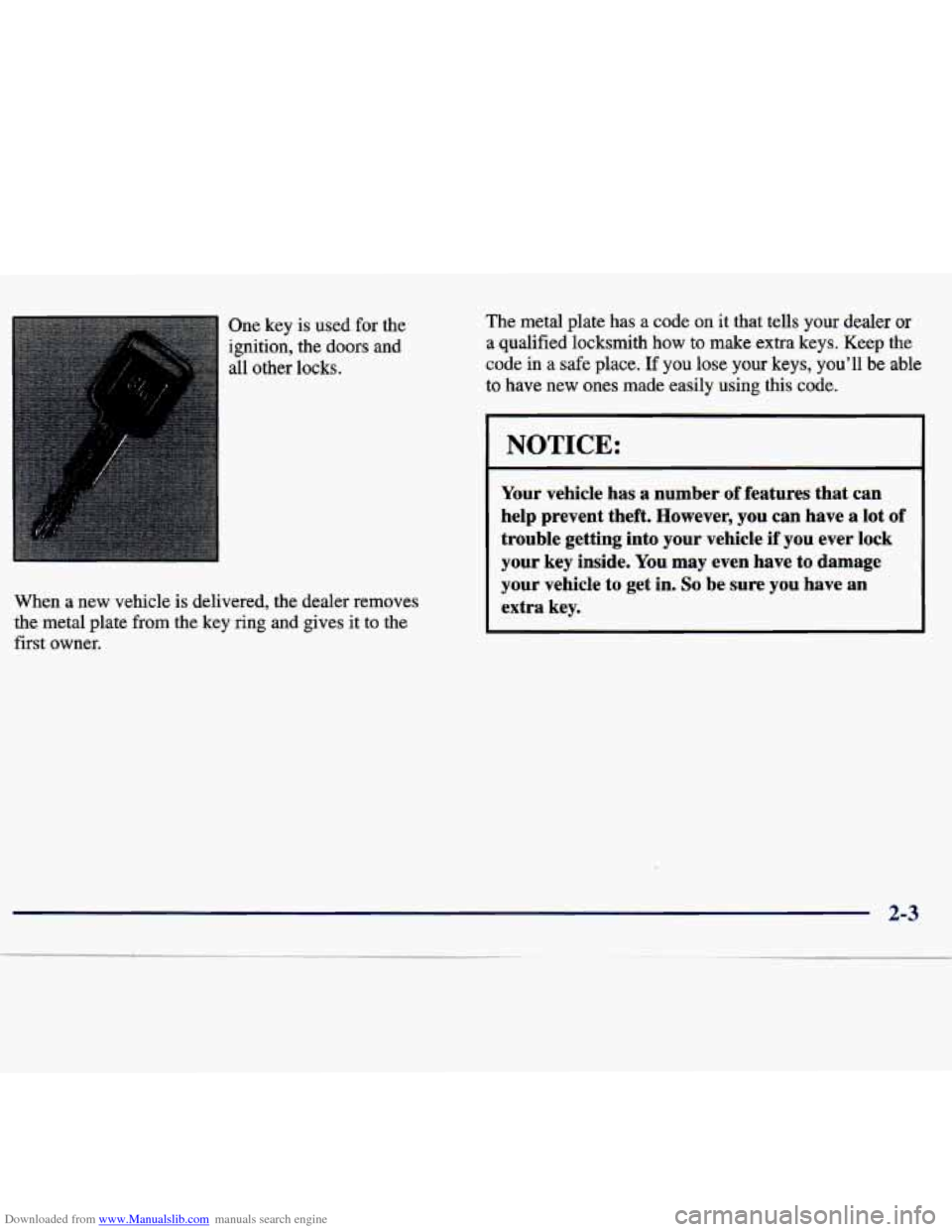
Downloaded from www.Manualslib.com manuals search engine One key is used for the
ignition, the doors
and
all other locks.
When a new vehicle
is delivered, the dealer removes
the metal plate from the key ring and gives it to the
first owner. The
metal plate has
a code on it that tells your dealer or
a qualified locksmith how
to make extra keys. Keep the
code in a safe place.
If you lose your keys, you’ll be able
1 :o have new ones made easily using this code.
NOTICE:
Your vehicle has a number of features that can
help prevent theft. However, you can have a lot
of
trouble getting into your vehicle if you ever lock
your key inside.
You may even have to damage
your vehicle to get in.
So be sure you have an
extra key.
Page 63 of 386
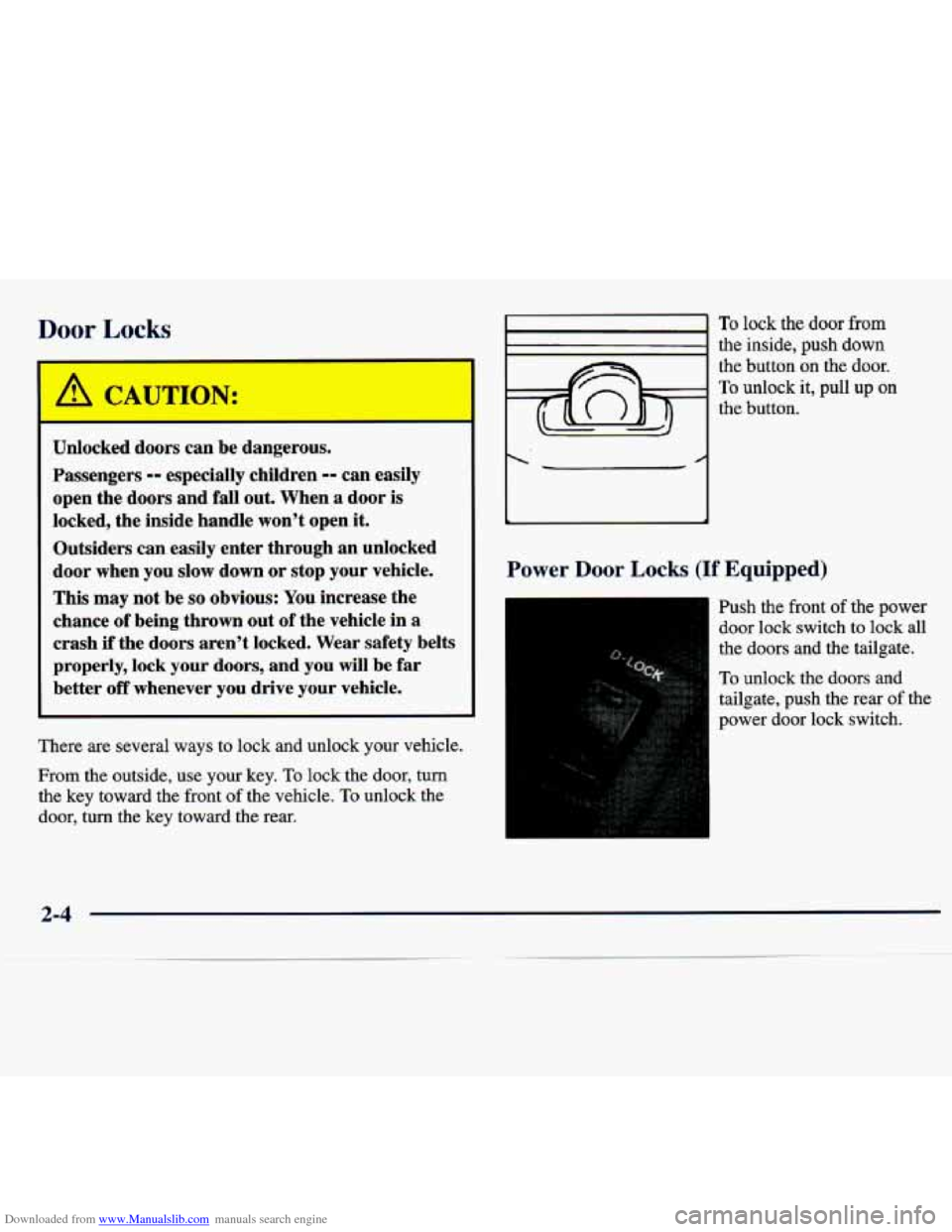
Downloaded from www.Manualslib.com manuals search engine Door Locks
Unlocked doors can be dangerous.
Passengers
-- especially children -- can easily
open the doors and fall out. When
a door is
locked, the inside handle won’t open it.
Outsiders can easily enter through an unlocked
door when you slow down or stop your vehicle.
This may not be
so obvious: You increase the
chance of being thrown out of the vehicle in
a
crash if the doors aren’t locked. Wear safety belts
properly, lock your doors, and you will be far
better
off whenever you drive your vehicle.
There are several
ways to lock and unlock your vehicle.
From the outside, use your key.
To lock the door, turn
the key toward the front of the vehicle.
To unlock the
door, turn the key toward the rear.
1
To lock the door from
the inside, push down
the button on the door.
To unlock it, pull up on
the button.
Power Door Locks (If Equipped)
Push the front of the power
door lock switch to lock all
the doors and the tailgate.
To unlock the doors and
tailgate, push the rear of the
power door lock switch.
2-4
Page 64 of 386
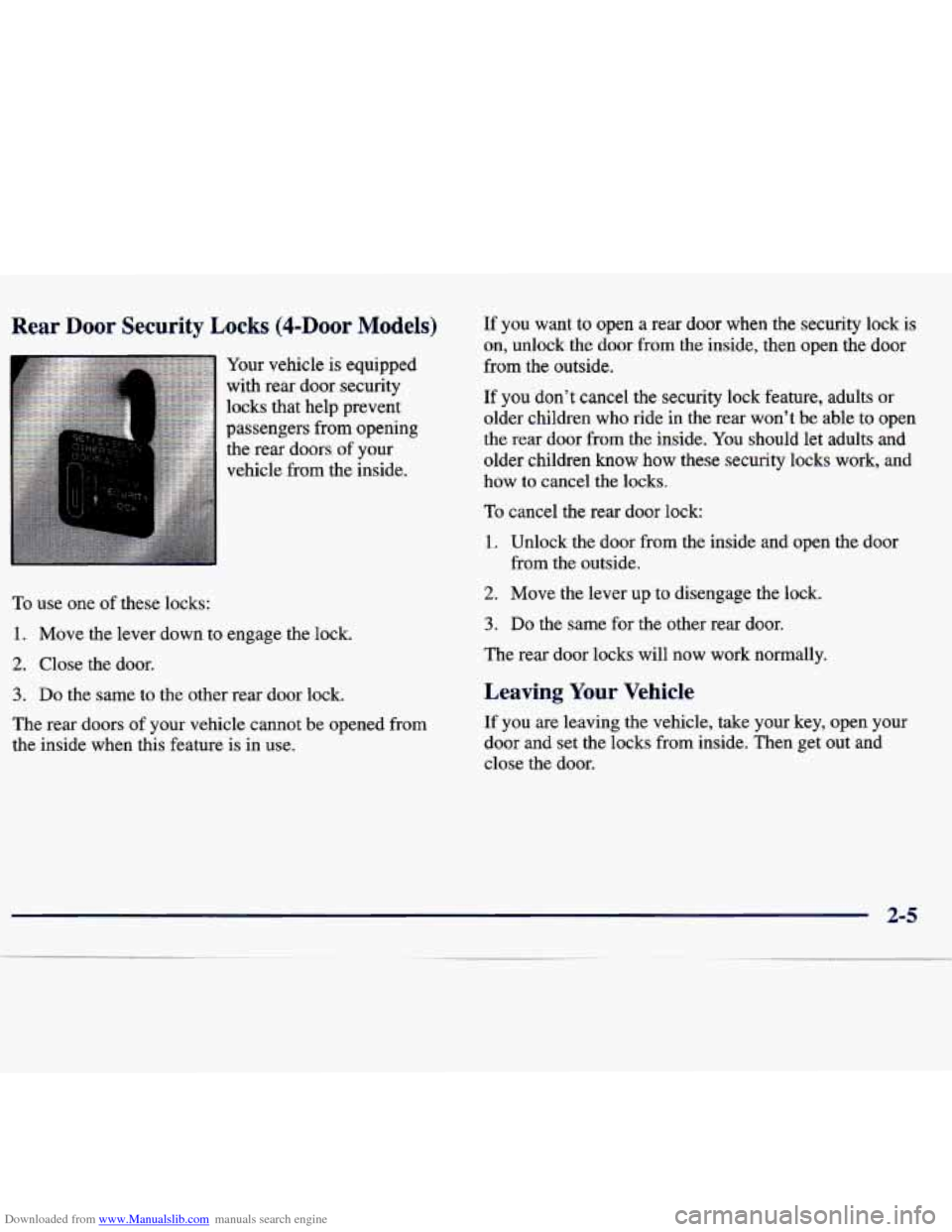
Downloaded from www.Manualslib.com manuals search engine Rear Door Security Locks (4-DOOr Models)
Your vehicle is equipped
with rear door security
locks that help prevent
passengers from opening
the rear doors of your
vehicle from the inside.
To use one of these locks:
1. Move the lever down to engage the lock.
2. Close the door.
3. Do the same to the other rear door lock.
The rear doors of your vehicle cannot be opened from
the inside when this feature is in use. If
you want to open a rear door when the security
lock is
on, unlock the door from the inside, then open the door
from the outside.
If you
don’t cancel the security lock feature, adults or
older children who ride in the rear won’t be able to open
the rear door from the inside.
You should let adults and
older children know how these security locks work, and
how to cancel the locks.
To cancel the rear door lock:
1. Unlock the door from the inside and open the door
from the outside.
2. Move the lever up to disengage the lock.
3. Do the same for the other rear door.
The rear door locks will now work normally.
Leaving Your Vehicle
If you are leaving the vehicle, take your key, open your
door and set the locks from inside. Then get
out and
close the door.
2-5
Page 65 of 386
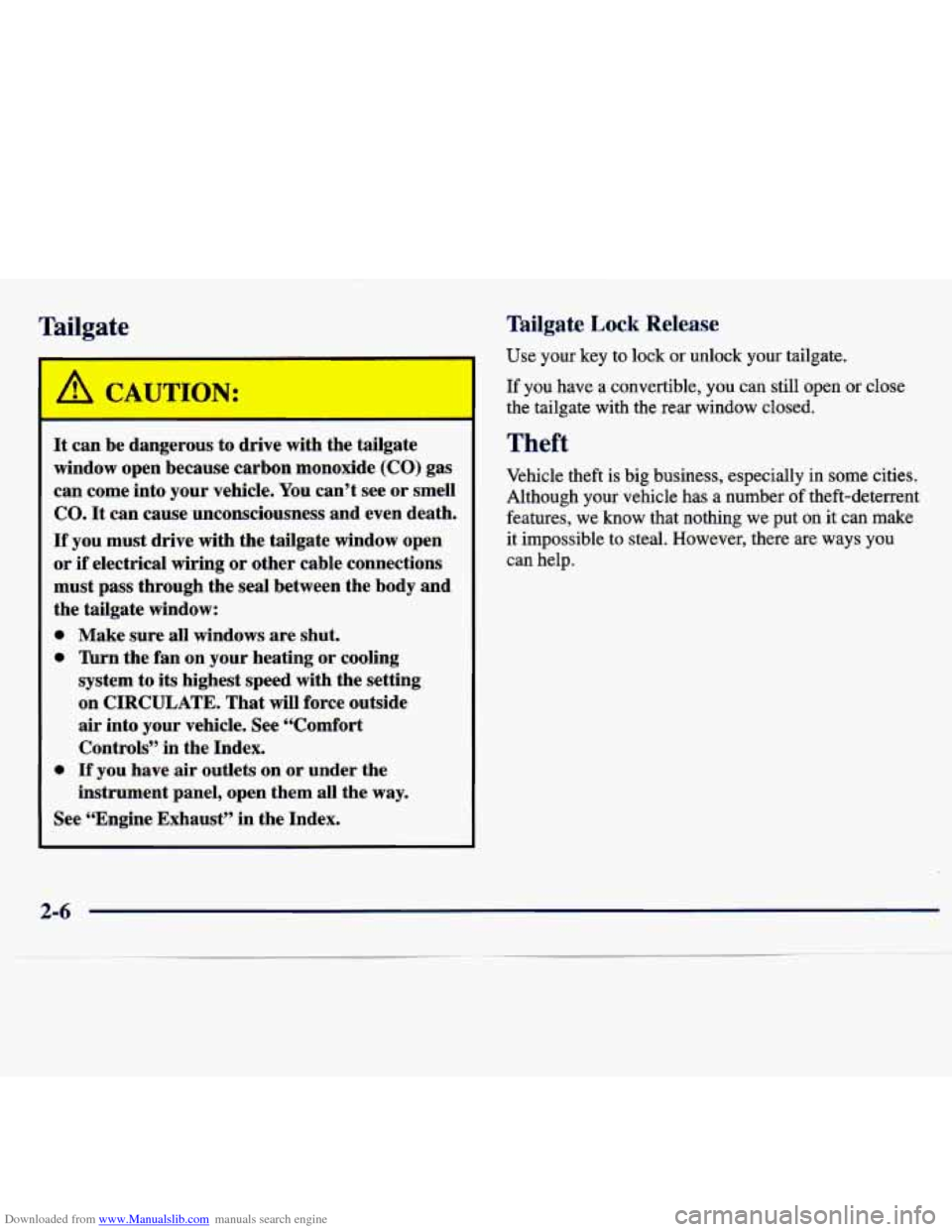
Downloaded from www.Manualslib.com manuals search engine Tailgate
It can be dangerous to drive with the tailgate
window open because carbon monoxide (CO) gas
can come into your vehicle. You can’t see or smell
CO. It can cause unconsciousness and even death.
If you must drive with the tailgate window open
or
if electrical wiring or other cable connections
must pass through the seal between the body and
the tailgate window:
0 Make sure all windows are shut.
0 ’hrn the fan on your heating or cooling
system to its highest speed with the setting
on CIRCULATE. That will force outside
air into your vehicle. See “Comfort
Controls” in the Index.
0 If you have air outlets on or under the
instrument panel, open them all the way.
See “Engine Exhaust” in the Index.
Tailgate Lock Release
Use your key to lock or unlock your tailgate.
If you have a convertible, you can still open
or close
the tailgate with the rear window
closed.
Theft
Vehicle theft is big business, especially in some cities.
Although
your vehicle has a number of theft-deterrent
features, we know that nothing we put on
it can make
it impossible to steal. However, there are ways
you
can help.
2-6
Page 66 of 386
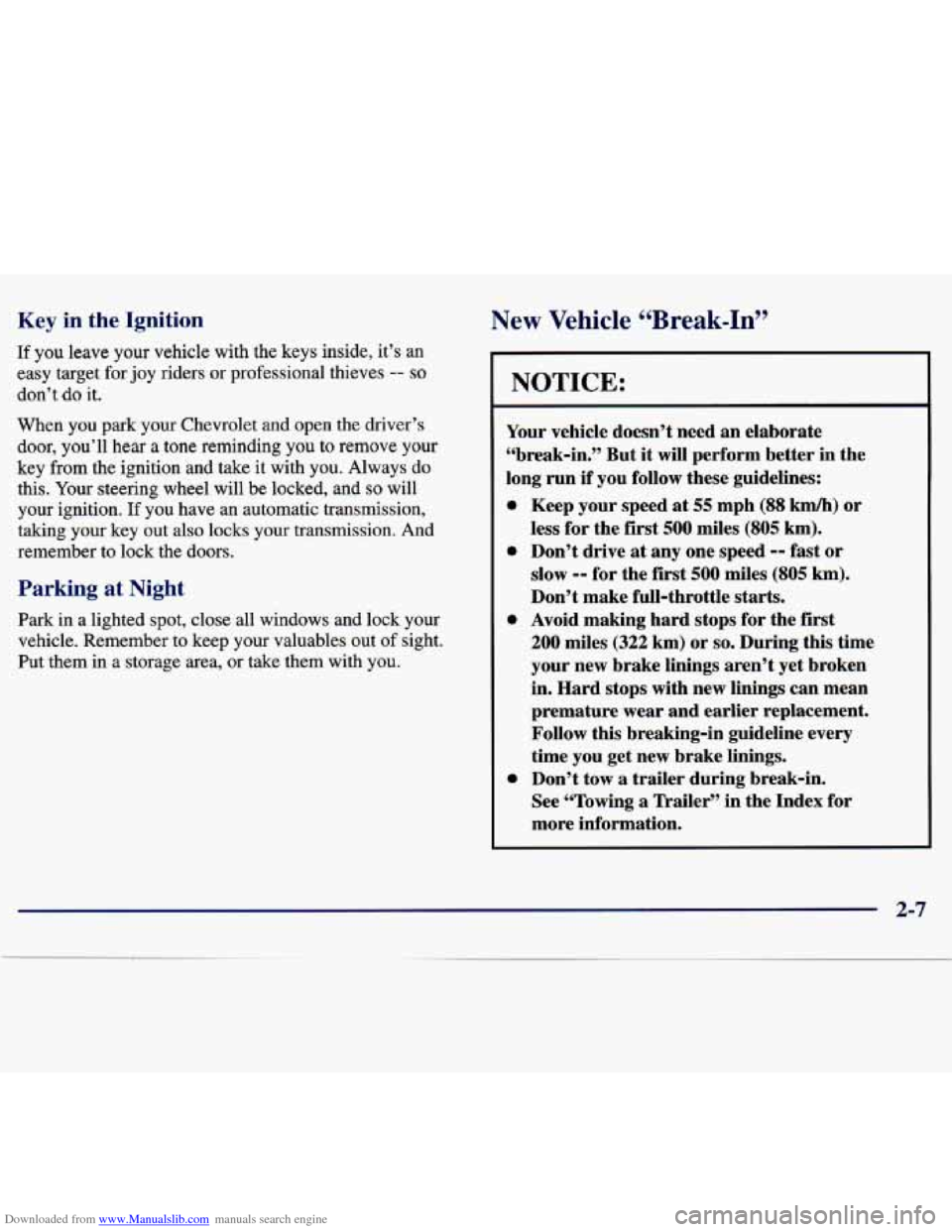
Downloaded from www.Manualslib.com manuals search engine Key in the Ignition
If you leave your vehicle with the keys inside, it’s an
easy target
for joy riders or professional thieves -- so
don’t do it.
When you park your Chevrolet and open the driver’s
door, you’ll hear a tone reminding you to remove your
key
from the ignition and take it with you. Always do
this. Your steering wheel will be locked, and so will
your ignition.
If you have an automatic transmission,
taking your key out also locks your transmission. And
remember
to lock the doors.
Parking at Night
Park in a lighted spot, close all windows and lock your
vehicle. Remember to keep your valuables out
of sight.
Put them in a storage area, or take them with
you.
New Vehicle ccBreak-InSS
NOTICE:
Your vehicle doesn’t need an elaborate
“break-in.)’ But
it will perform better in the
long run
if you follow these guidelines:
0
0
0
0
Keep your speed at 55 mph (88 kmh) or
less for the first 500 miles (805 km).
Don’t drive
at any one speed -- fast or
slow -- for the first 500 miles (805 km).
Don’t make full-throttle starts.
Avoid making hard stops for the
first
200 miles (322 km) or so. During this time
your new brake linings aren’t yet broken
in. Hard stops with new linings can mean
premature wear and earlier replacement.
Follow this breaking-in guideline every
time you get new brake linings.
Don’t tow
a trailer during break-in.
See “Towing
a Trailer” in the Index for
more information.
2-7
Page 67 of 386
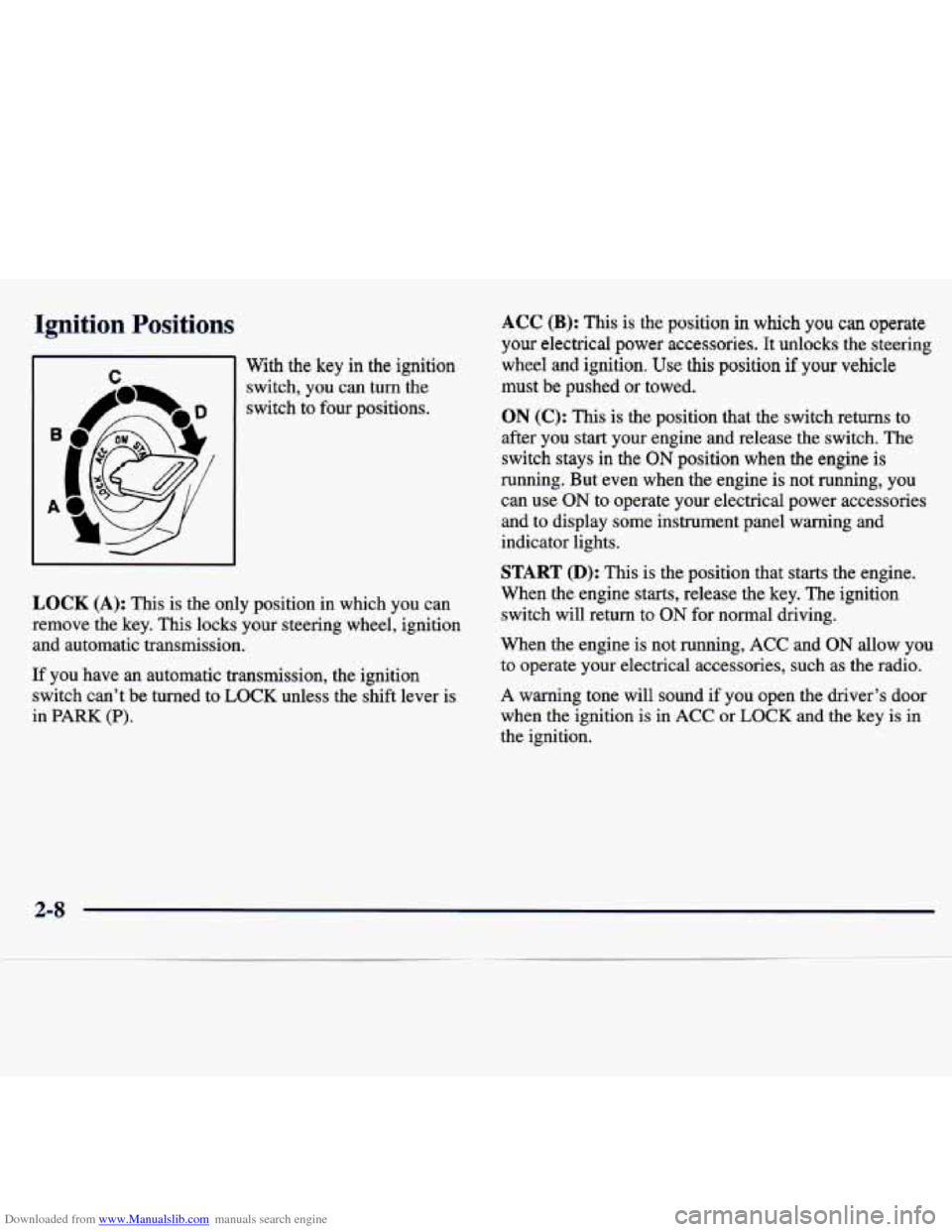
Downloaded from www.Manualslib.com manuals search engine Ignition Positions
m I With the key in the ignition
rr
4 I
switch, you can turn the
switch to four positions.
LOCK (A): This is the only position in which you can
remove the key. This locks your steering wheel, ignition and automatic transmission.
If you have
an automatic transmission, the ignition
switch can’t be turned to
LOCK unless the shift lever is
in
PARK (P).
ACC (B): This is the position in which you can operate
your electrical power accessories. It unlocks the steering
wheel and ignition. Use this position
if your vehicle
must be pushed or towed.
ON (C): This is the position that the switch returns to
after you start your engine and release the switch. The
switch stays in the
ON position when the engine is
running. But even when
the engine is not running, you
can use
ON to operate your electrical power accessories
and
to display some instrument panel warning and
indicator lights.
START (D): This is the position that starts the engine.
When the engine starts, release the key. The ignition
switch will return to
ON for normal driving.
When the engine is not running,
ACC and ON allow you
to operate your electrical accessories, such as the radio.
A warning tone will sound if you open the driver’s door
when the ignition is in
ACC or LOCK and the key is in
the ignition.
2-8
Page 68 of 386
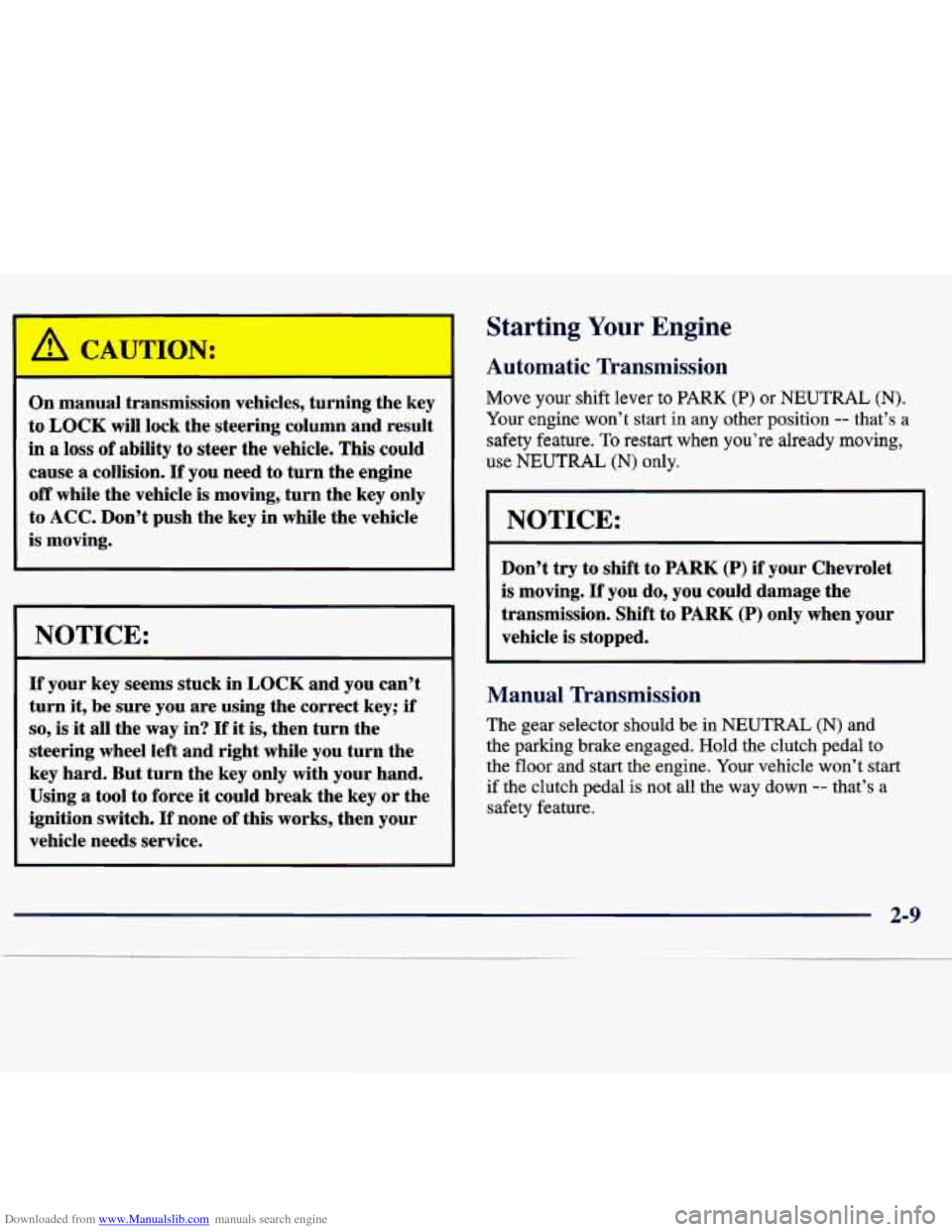
Downloaded from www.Manualslib.com manuals search engine A
On manual transmission vehicles, turning the key
to
LOCK will lock the steering column and result
in a loss of ability to steer the vehicle. This could
cause a collision.
If you need to turn the engine
off while the vehicle is moving, turn the key only
to
ACC. Don’t push the key in while the vehicle
is moving.
NOTICE:
If your key seems stuck in LOCK and you can’t
turn it, be sure you are using the correct key; if
so, is it all the way in? If it is, then turn the
steering wheel left and right while
you turn the
key hard. But turn the key only with your hand.
Using a tool to force it could break the key or the
ignition switch.
If none of this works, then your
vehicle needs service.
Starting Your Engine
Automatic Transmission
Move your shift lever to PARK (P) or NEUTRAL (N).
Your engine won’t start in any other position -- that’s a
safety feature. To restart
when you’re already moving,
use NEUTRAL (N) only.
I NOTICE:
Don’t try to shift to PARK (P) if your Chevrolet
is moving.
If you do, you could damage the
transmission. Shift to
PARK (P) only when your
vehicle
is stopped.
Manual Transmission
The gear selector should be in NEUTRAL (N) and
the parking brake engaged. Hold the clutch pedal to
the
floor and start the engine. Your vehicle won’t start
if the clutch pedal
is not all the way down -- that’s a
safety feature.
2-9
Page 69 of 386
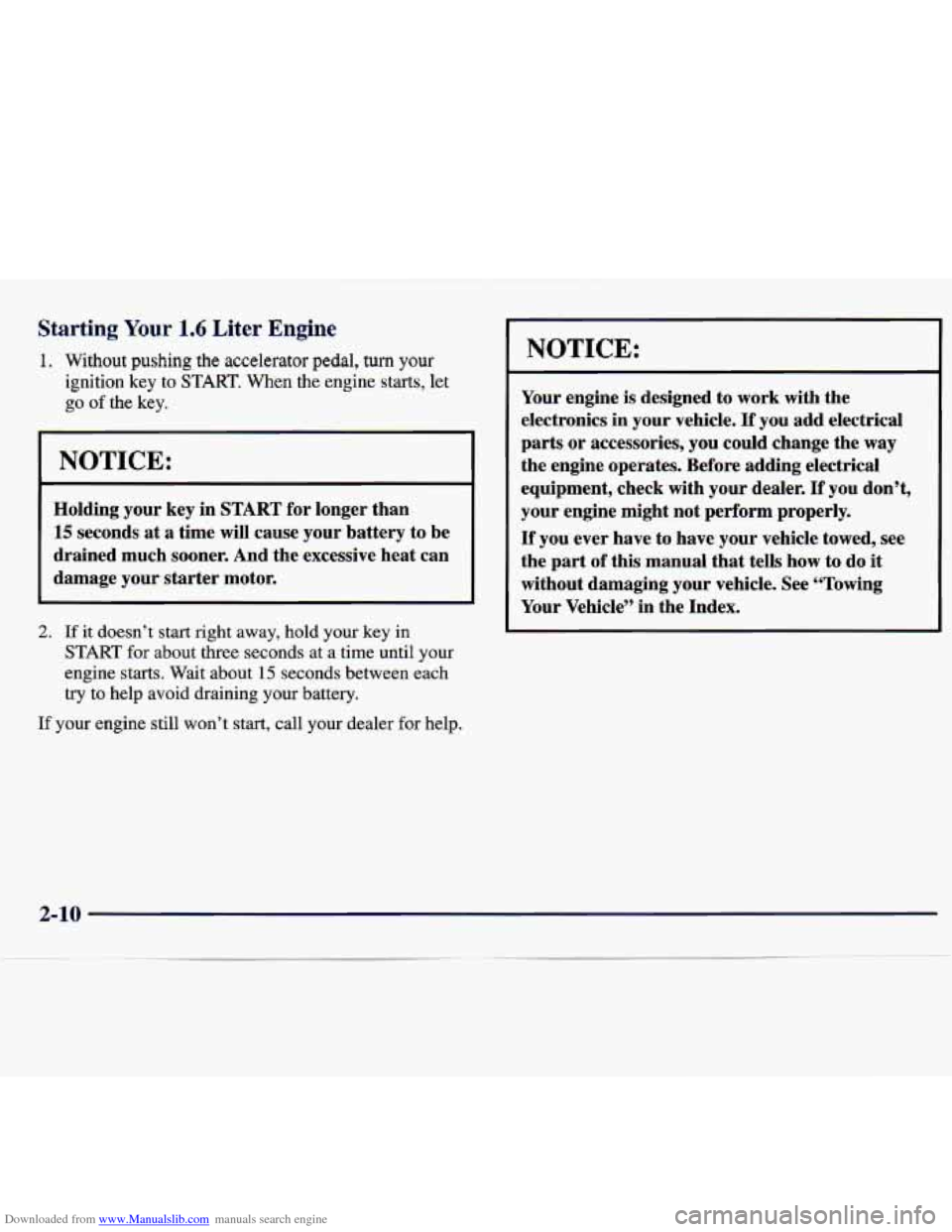
Downloaded from www.Manualslib.com manuals search engine Starting Your 1.6 Liter Engine
1. Without pushing the accelerator pedal, turn your
ignition key to START. When the engine starts, let
go of the key.
NOTICE:
Holding your key in START for longer than
15 seconds at a time will cause your battery to be
drained much sooner. And the excessive heat can
damage your starter motor.
2. If it doesn’t start right away, hold your key in
START for about three seconds at a time until your
engine starts. Wait about
15 seconds between each
try to help avoid draining your battery.
If your engine still won’t start, call your dealer for help.
NOTICE:
Your engine is designed to work with the
electronics in your vehicle.
If you add electrical
parts or accessories,
you could change the way
the engine operates. Before adding electrical
equipment, check with your dealer.
If you don’t,
your engine might not perform properly.
If you ever have to have your vehicle towed, see
the part of this manual that tells how to do
it
without damaging your vehicle. See “Towing
Your Vehicle” in the Index.
2-10
Page 70 of 386
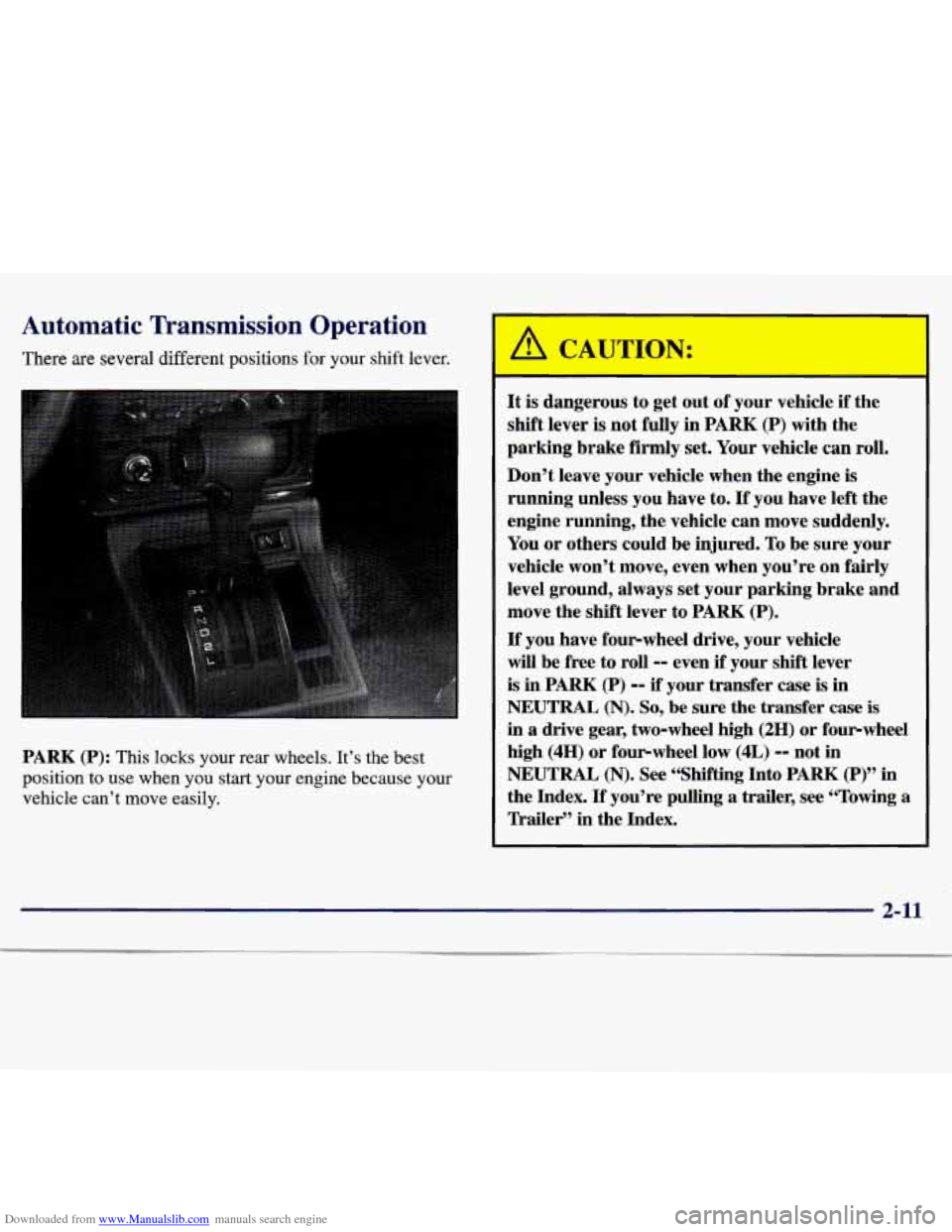
Downloaded from www.Manualslib.com manuals search engine Automatic Transmission Operation
There are several different positions for your shift lever.
PARK
(P): This locks your rear wheels. It’s the best
position to use when
you start your engine because your
vehicle can’t move easily. It
is dangerous to
get out of your vehicle if the
shift lever is not fully in
PARK (P) with the
parking brake firmly
set. Your vehicle can roll.
Don’t leave your vehicle when the engine is
running unless you have to.
If you have left the
engine running, the vehicle can move suddenly.
You or others could be injured. To be sure your
vehicle won’t move, even when you’re
on fairly
level ground, always set your parking brake and
move the shift lever to PARK
(P).
If you have four-wheel drive, your vehicle
will be free to roll
-0 even if your shift lever
is in PARK (P) -- if your transfer case is in
NEUTRAL (N). So, be sure the transfer case is
in a drive gear, two-wheel high (2H) or four-wheel
high (4H) or four-wheel low (4L)
-- not in
NEUTRAL
(N). See “Shifting Into PARK (P)” in
the Index.
If you’re pulling a trailer, see “Towing a
lkailer” in the Index.
2-11